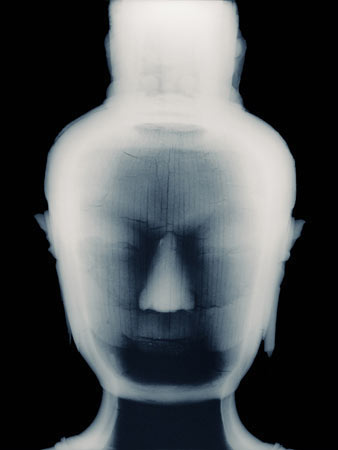
X-rays, a technology we take for granted except when biting down on dental films, became a matter of some controversy last year with the introduction of digital full-body scans for airport security. The exposure of naked skin beneath clothing is apparently more offensive to us than those images we are accustomed to, like roots of teeth beneath gums or skeletons beneath flesh. Naughty security people should remember the cautionary tale of Dr. Xavier (Ray Milland) in Roger Corman’s “X, The Man with the X-Ray Eyes.” Newly endowed with super-vision, the good doctor Xavier denudes dancing couples at a party with wry embarrassment — and not long after succumbs to madness. Moral of the story: Man was not meant to see too much.
David Maisel’s new series of photographs, “History’s Shadow,” uses X-rays on old artifacts instead of young bodies. The scanning technology that museums like the Getty Research Institute and San Francisco’s Asian Art Museum employ to study these objects inspired the photographer, whose work has often focused on “the dual processes of memory and excavation.” The sixteen photographs shown here mark the initial phase of a larger project. Here, Maisel chooses film exposures of ancient pottery and statuary and re-photographs them, backlit, atop a light table. His manipulations (including double-exposures) cause these artifacts to “become de-familiarized and decontextualized, though acutely alive and renewed. The ghostly images ... seem to surpass the power of the original works of art. These spectral renderings become transmissions from the distant past, conveying messages across time ...”
In Renaissance-era Spanish still-life paintings, objects from daily life arranged on tables, brightly lit, before black backgrounds, here take on an anything but realistic theatrical pathos. Maisel’s bluish-white phantasmal vessels, animals, deities, human figures and portraits are as silent, beautiful and alien as microorganisms; in them we discern (perhaps with our hallucinatory pineal eye) a meaningful, inexplicable presence.
